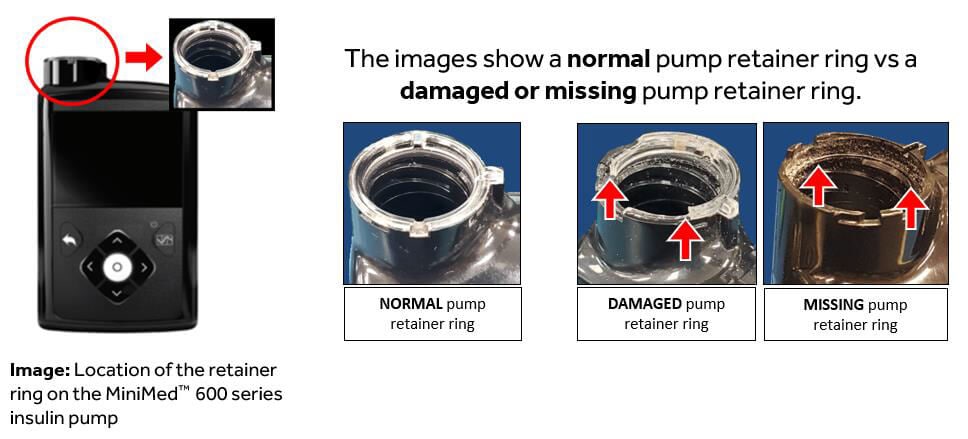URGENT RECALL
MiniMed™ 630G insulin pump (MMT-1715) and MiniMed™ 670G insulin pump (MMT-1780) - PUMP RETAINER RING
Because your safety is our top priority, we are making you aware of a potential safety risk.
Issue Description:
All MiniMed™ 600 series insulin pumps are designed with a pump retainer ring to lock the reservoir in the insulin pump. There have been reported incidents of a loose reservoir that can no longer be locked into the pump. The reservoir can become loose due to a broken or missing retainer ring that prevents a proper lock. The retainer ring can be broken, for example, as a result of dropping or bumping your pump on a hard surface.
If the reservoir is not properly locked into the pump, it could lead to over or under delivery of insulin, which could then result in hypoglycemia or hyperglycemia.
- For example, if the pump retainer ring is broken or becomes detached from the pump, and the user inserts the reservoir back into the pump while the infusion set is still connected to the body, it could result in a rapid infusion of insulin, which could cause hypoglycemia. The under delivery of insulin could occur if the reservoir is not properly locked in place by the retainer ring, creating a space between the pump and the reservoir, and preventing the pump from pushing the expected insulin into the body, which could cause hyperglycemia.
This issue may affect users on the MiniMed™ 600 series insulin pump. The pump model number can be found directly on the bottom or on the back of your device.
| Insulin Pump | Model Number |
|---|---|
| MiniMed™ 630G Insulin Pump | MMT-1715 |
| MiniMed™ 670G Insulin Pump | MMT-1780 |
ACTIONS REQUIRED:
- Examine the retainer ring on your pump.

- If the reservoir does not lock into the pump or the retainer ring is loose, damaged or missing, discontinue using the insulin pump and revert to a back-up plan of manual insulin injections per your doctor’s recommendations. DO NOT insert the reservoir back into your pump while connected because you could mistakenly give yourself a large insulin bolus, and go to www.medtronicdiabetes.com/PumpRing or contact our Medtronic 24-Hour Technical Support line at 1-877-585-0166.
- If your reservoir properly locks in place by the retainer ring, continue to use your pump. Remember to always follow the Instructions for Use on how to correctly insert the reservoir.
PRECAUTIONS RECOMMENDED FOR ALL PATIENTS
- If by accident you drop or bump your pump, check your pump and retainer ring for damage.
- Routinely examine your pump retainer ring and check that your reservoir locks in place at every set change.
Please visit www.medtronicdiabetes.com/PumpRing for additional information and answers to frequently asked questions.
At Medtronic, patient safety is our top priority, and we are committed to delivering safe and effective therapies of the highest quality and reliability possible. We appreciate your time and attention in reading this important recall notification.
As always, we are here to support you. If you have further questions or need assistance, please call our 24-Hour Technical Support at: 1-800-646-4633.
Frequently asked questions
Yes, it may affect all the MiniMed™ 600 series insulin pumps.
This recall notification does not apply to MiniMed™ Paradigm™ insulin pumps.
Please reference the ACTIONS REQUIRED section outlined in your Recall Notification.
If you are still uncertain if your pump is impacted, contact the Medtronic 24 -Hour Technical Support line to troubleshoot the device and to discuss this issue in further detail to determine if your device is impacted.
Damage to the pump retainer ring can occur as a result of dropping or bumping your pump on hard surfaces. By taking the necessary precautions found on your recall notice found under PRECAUTIONS RECOMMENDED FOR ALL PATIENTS, there are proactive actions that can be taken to prevent this issue from occurring.
- If by accident you drop or bump your pump, check your pump and retainer ring for damage.
- Routinely examine your pump retainer ring and check that your reservoir locks in place at every set change.
If the reservoir is not properly locked into the pump, it could lead to over or under delivery of insulin, which could then result in hypoglycemia or hyperglycemia.
-
For example, if the pump retainer ring is broken or becomes detached from the pump, and the user inserts the reservoir back into the pump while the infusion set still connected to the body, it could result in a rapid infusion of insulin, which could cause hypoglycemia. The under delivery of insulin could occur if the reservoir is not properly locked in place by the retainer ring, creating a space between the pump and the reservoir, and preventing the pump from pushing the expected insulin into the body, which could cause hyperglycemia.